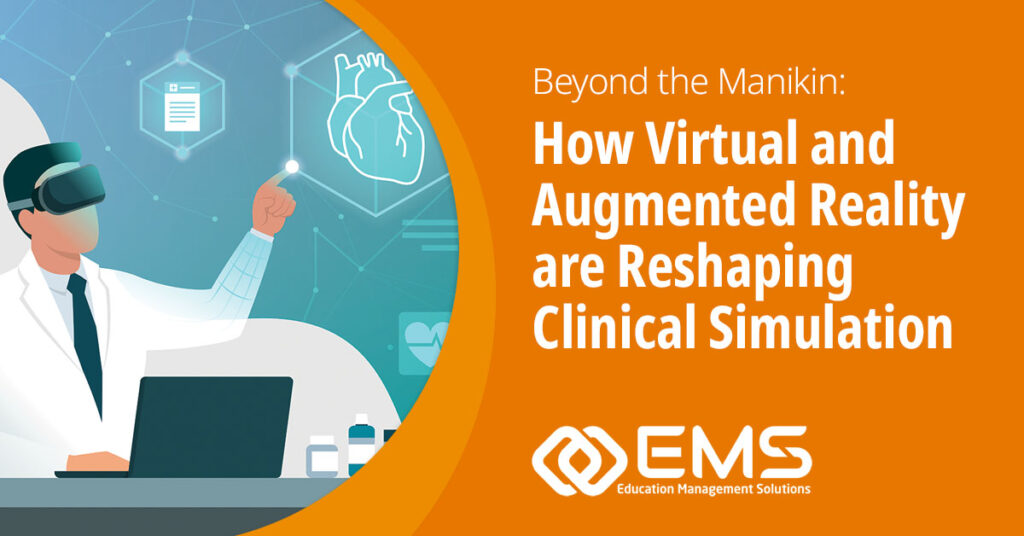Clinical simulation has come a long way from the days of static manikins and scripted scenarios. Today, Virtual Reality (VR) and Augmented Reality (AR) are ushering in a new era of immersive, dynamic learning experiences that reflect the complexities of real-world healthcare. These tools are doing more than just modernizing training—they’re redefining how medical professionals gain critical skills, make decisions under pressure, and prepare for high-stakes situations.
In this blog post, we’ll explore the transformative benefits of VR and AR in clinical simulation and dive into the innovations shaping their future.
Benefits of VR and AR in Healthcare Simulation
Immersion and Real-Time Interaction
One of the main benefits of using VR in healthcare simulation training is that it enables students or existing professionals to train in fully immersive 3D environments that replicate complex medical scenarios. By providing an unmatched level of training realism for surgeries, emergency care, or diagnostic procedures, users can practice and make decisions in lifelike conditions without risking patient safety. AR also enhances traditional training by overlaying virtual elements onto physical environments – for example, projecting anatomical models or procedural guides onto actual equipment, helping bridge the gap between theory and practice1.
Risk-Free, Cost-Effective Training
In some instances, healthcare simulation training often can involve a combination of equipment, consumables, and live patients, putting traditional methods out of reach for some programs due to cost restraints and logistics. VR/AR simulations can remove those barriers, creating safe, reusable environments for medical professionals to hone their skills providing scalable options that can reduce costs while maintaining instructional quality2.
Multi-Sensory Learning
VR/AR simulations engage multiple senses – visual, auditory, tactile, and sometimes even olfactory – allowing healthcare trainees to experience procedures as close as possible to those they would encounter in real life practice. For example, VR can simulate the sights and sounds of a busy operating room, while haptic feedback tools mimic the physical sensations of surgery. This multi-sensory approach is proven to help enhance memory retention and equips professionals with practical skills to apply in real-world situations2.
Enhanced Accessibility
AR and VR can assist in the expansion of healthcare training opportunities regardless of geographic location or resource constraints. Medical students or professionals can rehearse high-risk interventions, such as stroke treatment or trauma responses, from remote locations without needing a physical simulation lab3. AR, for instance, can overlay step-by-step procedural guides in the field, empowering professionals during live scenarios4.
The Future of VR/AR in Healthcare Simulation
As technology continues to reshape how medical professionals train, several exciting trends are emerging that promise to refine and enhance the VR/AR learning experience.
AI-Driven Personalization
With artificial intelligence (AI), training scenarios can be tailored to the unique needs and skill levels of individual learners. Imagine a surgical resident working through a virtual operation with AI analytics assessing their performance in real time and adjusting the complexity of tasks or introduce new challenges based on their growth over time.
Enhanced Haptic Feedback
Haptic feedback systems replicate the sensations of touch, pressure, and resistance, enabling healthcare professionals to develop fine motor skills critical for intricate procedures—like suturing, laparoscopic surgery, or catheter insertion. As haptic systems become increasingly sophisticated, learners can rehearse high-precision techniques with an unprecedented level of realism.
Integrated Performance Tracking
To make VR/AR-based training even more impactful, future systems will increasingly connect seamlessly with existing simulation management platforms. This integration will allow educators and administrators to track learner progress, measure competency, and assess performance across multiple training sessions. Through detailed analytics, institutions can ensure that medical professionals are meeting specific benchmarks and even identify areas where additional attention or practice may be needed. This coupling of VR/AR with robust data management tools creates a feedback loop that elevates the effectiveness of simulation-based learning.
As the role of VR and AR in clinical simulation continues to expand, the opportunities for enhanced, efficient, and cost-effective training are becoming more evident.
At Education Management Solutions, we are dedicated to providing comprehensive support and cutting-edge simulation management solutions designed to meet your specific needs. To learn more about how our expertise can elevate your training programs and optimize your resources, contact EMS today. Let us help you lead the way in transforming healthcare education and training.

